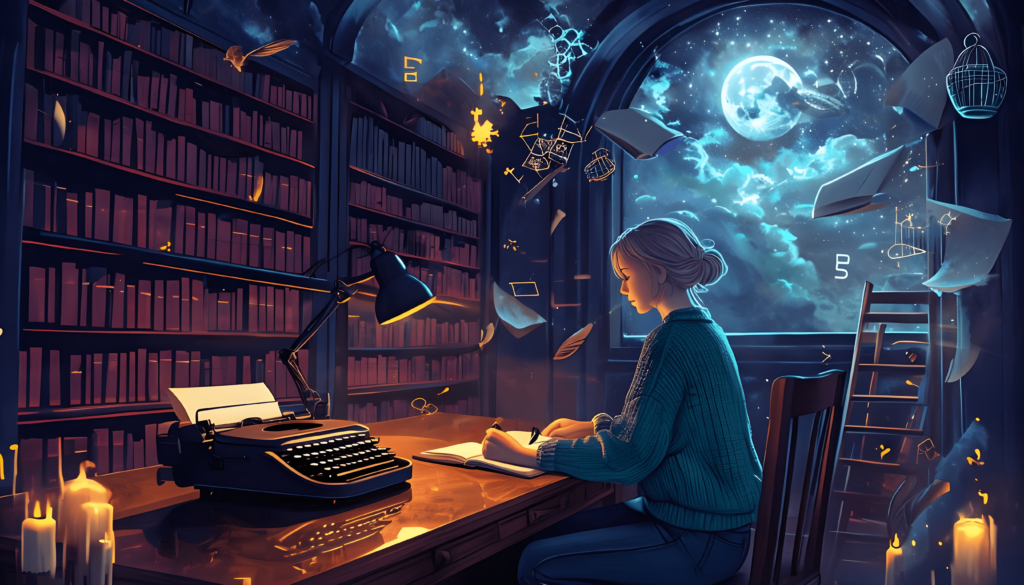
Table of Contents
ToggleTABLE OF CONTENT
How to make your creative writing better
Let’s talk about Creative Writing
Why Creative Writing Matters
Step 1: Read Like a Writer
Step 2: Write Every Day
Step 3: Show, Don’t Tell
Step 4: Develop Unique Characters
Step 5: Embrace the Power of Editing
Step 6: Experiment with Different Styles and Genres
Step 7: Join a Writing Community
Step 8: Master the Art of Description
Step 9: Seek Feedback
Step 10: Keep Learning
FAQs: How to Make Your Creative Writing Better
Conclusion
HOW TO MAKE YOUR CREATIVE WRITING BETTER
Firstly, creative writing is not an easy thing to do, it demands lots of patience, dedication, curiosity and obviously practice.
If you are in your early stage of writing or you are a writer who is someone who is looking for inspiration and wants to make his or her writing craft better so believe us by the ending of this article you will find a way for betterment.
Because you would find an answer to the question How to make your creative writing better!
Creative writing is challenging but not an impossible thing to master! Making your creative writing better is not rocket science. By just following a few fundamental rules and some tips and techniques you can get better at your craft!
And this is a task where most aspiring writers gave up because of lack of patience and dedication.
Remember writing is not a one day journey it is a process of lifetime. So be patient and learn these fundamental rules to become better at your creative writing!
LET'S TALK ABOUT CREATIVE WRITING :
So do you have a passion for storytelling but feel like your creative writing could use a boost? Maybe you’re stuck in a writing rut, or your words don’t quite sparkle the way you want them to. Don’t worry—you’re not alone! Learning how to make your creative writing better is a journey every writer takes, and the good news is, it’s a skill you can develop with time and practice.
This article is your personalized guide to improve your creative writing. Let’s dive into practical tips and actionable steps that will help you unlock your potential and write stories that captivate your readers.
WHY CREATIVE WRITING MATTERS
Creative writing isn’t just about putting words on paper—it’s about expressing yourself, crafting vivid worlds, and connecting with readers on an emotional level. Whether you’re writing short stories, novels, poems, or scripts, improving your craft will:
Enhance your storytelling abilities: Bring your characters and plots to life.
Boost your confidence: Feel proud of the stories you create.
Open doors to opportunities: From publishing to competitions, better writing opens up new possibilities.
So, if you’re ready to make your creative writing shine, let’s get started!
Tip : While reading this, think, what story came to your mind! Now think critically about it, maybe it is a story of any Novel, Movie or Web-series! Just analyse the story, why that story stands out! Why do you feel connected to that story? Why do you remember it till now? Just ask yourself from a writer’s perspective!

STEP 1 : READ LIKE A WRITER
“Reading is the creative centre of a writer’s life.” –
“That’s a very good way to learn the craft of writing – from reading.”
To write well, you need to read well. But this isn’t just about enjoying a good book—it’s about reading critically. Here’s how you can start reading like a writer:
- Pay attention to structure: How does the author organize their story?
- Study descriptions: Notice how settings and emotions are portrayed.
- Analyze dialogue: How do characters’ conversations feel natural yet purposeful?
- Note the tone: Is it formal, humorous, or dark? How does it suit the story?
Pro Tip: Keep a notebook handy while reading to jot down techniques or lines that inspire you.
STEP 2 : WRITE EVERY DAY
There is no substitute for consistency! Consistency is key to improving your creative writing. Even if it’s just a paragraph or a journal entry, writing daily builds your skills and keeps your creativity flowing. Here’s how you can stay on track:
Set small goals: Aim for 200-500 words per day to make the task manageable.
Create a routine: Write at the same time and place every day to build a habit.
Use prompts: If you’re stuck, use creative writing prompts to spark ideas.
Example Prompt: Write a story about a mysterious boy who comes from somewhere at 12 O’clock at night and stares at the main street lamp!
STEP 3 : SHOW DON'T TELL
One of the most important rules in creative writing is show, don’t tell. This means instead of stating facts, you should paint a picture that allows readers to experience the story themselves.
Example:
Telling: “She was angry.”
Showing: “Her fists clenched, and her face turned red as she slammed the door behind her.”
By using sensory details, actions, and dialogue, you can create more immersive and engaging writing.
STEP 4: DEVELOP UNIQUE CHARACTERS
Great creative writing often starts with unforgettable characters. To make your characters stand out:
Give them flaws: Perfect characters are boring. Show their struggles and imperfections.
Write detailed backstories: Even if it doesn’t make it into the story, knowing your characters’ pasts will help you write them authentically.
Use distinct voices: Each character should speak and act in a way that reflects their personality.
Pro Tip: Interview your characters. Ask them questions about their motivations, fears, and desires—it’s a fun way to bring them to life!
STEP 5: EMBRACE THE POWER OF EDITING
First drafts are rarely perfect, and that’s okay. Editing is where the magic happens. Here’s how to refine your creative writing:
Step away: Take a break after writing so you can return with fresh eyes.
Read aloud: This helps you catch awkward phrasing or repetitive words.
Cut unnecessary words: Be ruthless—if a word, sentence, or paragraph doesn’t add value, remove it.
Focus on flow: Ensure each sentence transitions smoothly to the next.
Pro Tip: Use tools like Grammarly or ProWritingAid to catch grammar and style issues.
STEP 6: EXPERIMENT WITH DIFFERENT STYLES AND GENRES
If you always write the same type of story, it’s time to shake things up! Experimenting with new styles and genres can help you discover new skills and perspectives. Try:
Writing poetry to improve your use of imagery and rhythm.
Exploring fantasy or sci-fi to expand your imagination.
Attempting flash fiction (stories under 1,000 words) to sharpen your brevity.
You might just find a new favorite genre—or uncover a hidden talent!
STEP 7: JOIN A WRITING COMMUNITY
Writing doesn’t have to be a solitary pursuit. Joining a community of writers can provide invaluable feedback, motivation, and inspiration. Here’s how to get involved:
Online forums: Check out online forums for writing!
Local groups: Look for writing workshops or meetups in your area.
Social media: Follow hashtags like #writers or #writerscommunity on Twitter or Instagram. Or you can just follow our instagram page to enhance your writing craft!
Sharing your work and engaging with other writers will help you grow and stay motivated.
STEP 8: MASTER THE ART OF DESCRIPTION
The best creative writing transports readers into the world you’ve created. To make your descriptions vivid and engaging:
Use sensory details: What do your characters see, hear, smell, taste, and touch?
Avoid clichés: Instead of “as cold as ice,” try something fresh and unique.
Be concise: Too much description can overwhelm the reader—find the balance.
Exercise: Describe an ordinary object (like a coffee cup) in three unique ways.
Pro Tip : you can also read a series of books titled “Before the coffee gets cold” by Toshikazu Kawaguchi! His books are one of the best examples of balanced descriptive writing!
STEP 9: SEEK FEEDBACK
Constructive feedback is one of the most effective ways to improve your creative writing. Share your work with trusted friends, writing groups, or mentors and ask for specific critiques. Questions to ask include:
Does the story hold their attention?
Are the characters believable?
Is the dialogue natural?
Remember, feedback isn’t personal—it’s a tool to help you grow.
STEP 10: KEEP LEARNING
The world of creative writing is vast, and there’s always more to learn. To keep improving:
Take courses: Platforms like Udemy, Coursera, and MasterClass offer great writing classes.
Read craft books: Some classics include On Writing by Stephen King and Bird by Bird by Anne Lamott. You can also read this article on “BEST BOOKS FOR DEVELOPING WRITING SKILLS”
Attend workshops: Many communities and online forums host writing workshops for all levels.
BONUS TIPS FOR MAKING YOUR CREATIVE WRITING BETTER
- Write what you love: Passion shines through in your writing.
- Be patient: Improvement takes time—don’t rush the process.
- Read widely: The more you read, the more tools you’ll have in your creative toolbox.
- Stay curious: Explore new topics, ideas, and perspectives to fuel your creativity.
We believe that you find this article informative if so then read some more informative articles to enhance your writing!
FAQS: HOW TO MAKE YOUR CREATIVE WRITING BETTER
Q: Can anyone become a better creative writer?
A: Absolutely! Writing is a skill that improves with practice, feedback, and persistence.
Q: What’s the best way to overcome writer’s block?
A: Try freewriting, changing your environment, or writing about a completely unrelated topic to reignite your creativity.
Q: How can I make my writing more unique?
A: Draw from your personal experiences, experiment with new genres, and trust your voice—no one else can tell your stories the way you can.
CONCLUSION
Improving your creative writing isn’t about achieving perfection—it’s about growth, exploration, and finding your unique voice. By reading critically, writing consistently, and embracing feedback, you can take your stories to the next level. Remember, every great writer started as a beginner, and the only way to get better is to keep writing.


